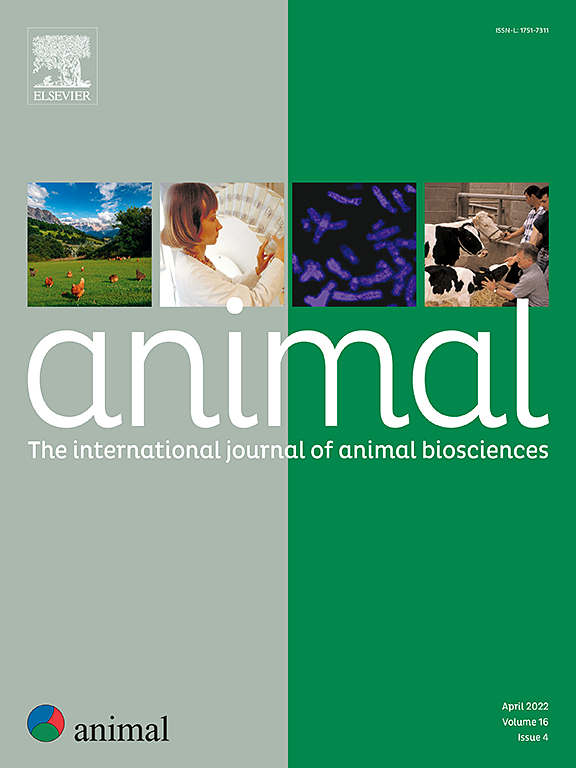CRISPR-Cas9 gene-editing to assess the role of RF-amide−related peptide 3 in ovine seasonal breeding
IF 4
2区 农林科学
Q1 AGRICULTURE, DAIRY & ANIMAL SCIENCE
引用次数: 0
Abstract
Seasonal breeding is an adaptive strategy that ensures the birth of the offspring during the best time of year and allows energy saving in times of food scarcity and adverse environmental conditions. At temperate and polar latitudes, photoperiod is the main synchroniser of seasonal functions, which exerts its action through melatonin. Within the pars tuberalis of the anterior pituitary, melatonin triggers a series of events that lead to enhanced local triiodothyronine (T3) production in the medio-basal hypothalamus specifically under long days and ultimately drive the appropriate GnRH output at the median eminence. How T3 governs GnRH output is mostly unknown but neuronal populations that respectively produce KISS1 and RFRP3 appear to be involved. However, while the role of KISS1 as a major GnRH secretagogue is undisputed, the function of RFRP3 in the control of (seasonal) breeding remains enigmatic, with conflicting results hinting at elusive mechanisms. Therefore, we launched an extensive series of experiments in sheep, aimed at invalidating the NPVF gene, which encodes RFRP3, using CRISPR-Cas9 technology. Here, we report on the generation of six sheep for which the NPVF gene has been successfully edited. Four of these animals bear at least one allele expected to behave as a null and constitute founders for distinct ovine lines. These founder sheep will now enter a standard breeding scheme in order to obtain male and female homozygotes for distinct mutations. These animals are expected to provide a clear delineation of the function of RFRP3 in seasonal breeding.
利用CRISPR-Cas9基因编辑技术评估rf -酰胺相关肽3在绵羊季节性育种中的作用
季节性繁殖是一种适应性策略,确保后代在一年中最好的时间出生,并在食物短缺和不利环境条件下节省能源。在温带和极纬度地区,光周期是季节性功能的主要同步者,它通过褪黑激素发挥作用。在垂体前叶结节部内,褪黑激素触发一系列事件,导致长时间下丘脑中基底部局部三碘甲状腺原氨酸(T3)产生增强,并最终驱动中隆起处适当的GnRH输出。T3是如何控制GnRH输出的尚不清楚,但分别产生KISS1和RFRP3的神经元群似乎参与其中。然而,虽然KISS1作为GnRH的主要促分泌物的作用是毋庸置疑的,但RFRP3在控制(季节性)繁殖中的功能仍然是一个谜,相互矛盾的结果暗示了难以捉摸的机制。因此,我们在绵羊中开展了一系列广泛的实验,旨在利用CRISPR-Cas9技术验证编码RFRP3的NPVF基因的有效性。在这里,我们报道了成功编辑NPVF基因的六只羊。这些动物中有四只至少有一个等位基因被认为是无效的,并构成了不同绵羊系的创始人。这些创始羊现在将进入一个标准的育种计划,以获得不同突变的雄性和雌性纯合子。这些动物有望为RFRP3在季节性育种中的功能提供清晰的描述。
本文章由计算机程序翻译,如有差异,请以英文原文为准。
求助全文
约1分钟内获得全文
求助全文
来源期刊

Animal
农林科学-奶制品与动物科学
CiteScore
7.50
自引率
2.80%
发文量
246
审稿时长
3 months
期刊介绍:
Editorial board
animal attracts the best research in animal biology and animal systems from across the spectrum of the agricultural, biomedical, and environmental sciences. It is the central element in an exciting collaboration between the British Society of Animal Science (BSAS), Institut National de la Recherche Agronomique (INRA) and the European Federation of Animal Science (EAAP) and represents a merging of three scientific journals: Animal Science; Animal Research; Reproduction, Nutrition, Development. animal publishes original cutting-edge research, ''hot'' topics and horizon-scanning reviews on animal-related aspects of the life sciences at the molecular, cellular, organ, whole animal and production system levels. The main subject areas include: breeding and genetics; nutrition; physiology and functional biology of systems; behaviour, health and welfare; farming systems, environmental impact and climate change; product quality, human health and well-being. Animal models and papers dealing with the integration of research between these topics and their impact on the environment and people are particularly welcome.
 求助内容:
求助内容: 应助结果提醒方式:
应助结果提醒方式:


